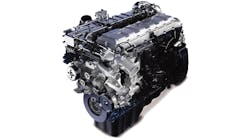After redirecting its Class 8 truck engine design program midway through last year, Navistar Inc. finally has received U.S. Environmental Protection Agency certification for one of its large truck engines incorporating selective catalytic reduction (SCR) emissions technology. The truck and engine builder started shipping trucks with the new technology in December, and now it indicates that EPA certifies its 13-liter heavy-duty engine at or below the required 0.20 g/bhp-hr NOx.
Navistar originally adopted “exhaust gas recirculation” (EGR) technology to treat NOx in compliance with EPA’s 2010 emissions standards.
EGR recirculates part of a diesel engine's exhaust gas to the cylinders, where it replaces some excess oxygen prior to combustion. The EGR method that Navistar used is one that EPA engineers originated and Navistar licensed, and then co-developed with EPA for commercial applications, but it was ruled ineffective at meeting the 2010 standard.
EPA determined in February 2012 that the company faced non-compliance penalties of up to $2,000/day for each engine it sold that failed to meet the federal standard of 0.20 grams of nitrogen oxide per brake-horsepower hour.
Last August, Navistar adopted the SCR method that EPA had approved for Navistar’s competitor Cummins Inc. Navistar introduced its InternationalProStar Class 8 with a Cummins ISX 15-liter engine in December, under a supply agreement the two companies developed after Navistar withdrew its EGR-based engines.
Now, Navistar is introducing ProStar trucks outfitted with its own 13-liter engine with SCR technology. Navistar now offers a full line-up of commercial truck engines with SCR emissions control.
"EPA certification of our proprietary 13-liter engine with SCR completes our transition to SCR-based technology for our heavy-duty engines," stated exec. vice president and chief operating officer Jack Allen. "We've reached another milestone in our emissions strategy transition and are on track to deliver our first ProStar units with our SCR-based 13-liter engines at the end of April."








